Aikibatto 9 DetailsHarai ATE
DetailsAspects and considerations already treated in a previous exercise of Aikibatto, are omitted here.
Particularly in aikido style defense, the harai does not have much to do with avoiding uke's attack, since there is always a taisabaki move with the whole body for that purpose. Instead, the warding off movement is intended to direct uke into a particular move to do next, an impulse which uke should follow without thinking, if correctly applied. Also, as mentioned above, the harai creates another rhythm, timing, because of the slightly longer time it takes for uke to readjust for the next attack. The harai makes uke's initial attack prolonged beyond where uke has optimal balance and control — a bit like a push in the back of somebody walking by. There will be a stumbling, if only momentary, maybe only in the upper body — but still, that slows uke down somewhat. In aikido too, the harai warding off is utilized in many techniques. Often, but not only, when uke attacks with strikes, such as shomen uchi or tsuki. Harai is also used when uke grabs for gyakuhanmi katatedori, but is warded off by tori's other hand before reaching the wrist. In karatedo, almost every block is a harai, more or less in the same sense.
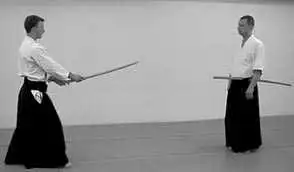 Starting position. Tori at right, uke at left. Ate, strike, is the first of the two Harai, named after the punch at middle level done with the tsuka, the hilt, in movement five. The warding off, done in the previous movement, gives uke a tendency to almost fall into the strike, which makes it more powerful. This striking with the hilt, tsuka ate, is found in many a iaido kata — aiming either for the belly, as done here, or for the head. Uke is not cutting in the beginning of this exercise, but making chudan tsuki, a thrust with the sword at middle level. This technique is done with quite a short move forward of the sword, or uke would be too much out of balance already before the harai, and also uke's wrists would be too much exposed to a kote technique. Uke must be credited with a wiser behavior than that. To reach with the tsuki, without stretching the arms too much forward, uke simply has to step in close before doing the thrust. Uke should have come so near, that the sword point would almost touch tori's front, were tori remaining on the spot. Then the tsuki thrust is only about a foot long — the equivalent of uke's body from front to back. Sometimes the blade is turned in tsuki, so that the edge points to the left or right instead of downward. This has practical reasons, relating to how to pierce a body, especially when wearing some kind of armour, or when hitting at the ribs. Here, though, the blade is kept at the same angle as in the original chudan kamae — not that it would make any difference to tori.
The left hand, though, can and should grip the sword firmly — right where the tsuba, the sword guard, would be. More precisely, when done with a real sword, the left hand grip is in the saya, the scabbard, right below the tsuba, and the thumb is on the tsuba, holding the sword firmly inside the scabbard. The sword should not be drawn even the least out of the scabbard, when harai is done.
The end of the hilt, the kashira, hits uke in the belly — ideally in the solar plexus, but that should be avoided in partner practice. Still, there should be some contact between tori's bokken and uke's belly in this exercise, although handled with care, so as to learn correct timing, distance and balance.
This pushing of uke is not only a way of learning a proper extension of the tsuki technique, but also for the purpose of creating enough room to draw the sword. When tori pushes uke back one full step, there is room between them for a safe draw.
The men cut is really intended to go down to chudan level, when not practicing with a partner. Here, though, the lowering of the sword to that position is done when uke has backed away. At the same time, left foot moves further back — as it would in an actual chudan giri, cut to middle level.
Contrary to most other noto, when the blade has entered the scabbard completely, it is not the left foot stepping up to the right one, but the right foot steps back to the left — not that it is of immense significance, but still. The best harmony of the move, then, is to take this step in a sliding way at the same time as the blade enters the scabbard, and not after. Then the sword and the body both move backward, together. Just as with other noto,though, the right hand finishes by sliding along the hilt to its end, the kashira, in this case on its underside.
Iai considerationsIn iai style single training of the tori movements in this exercise, the modifications of the above would be: a full thrust without any halfway stop in the tsuka ate technique, a proper extension of the do cut, and the men cut should go all the way down to chudan level.Uke's movements in this exercise are not very meaningful to practice in a iai solo style.
Stefan Stenudd Table of movementsNext exercise© Stefan Stenudd, 2000. You are free to any non-commercial use of this material, without having to ask for my permission. But please refer to this website, when doing so.
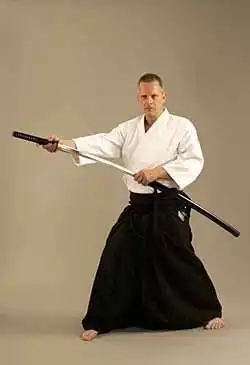
AikibattoIntroductionBackgroundAikibatto BasicsSword exercisesJo staff exercisesSolo video clipsDuo video clipsKen suburiCorrectionsGlossaryVisitor responseShinken, the swordAikibatto — the book
About CookiesMy Other WebsitesCREATION MYTHSMyths in general and myths of creation in particular.
TAOISMThe wisdom of Taoism and the Tao Te Ching, its ancient source.
LIFE ENERGYAn encyclopedia of life energy concepts around the world.
QI ENERGY EXERCISESQi (also spelled chi or ki) explained, with exercises to increase it.
I CHINGThe ancient Chinese system of divination and free online reading.
TAROTTarot card meanings in divination and a free online spread.
ASTROLOGYThe complete horoscope chart and how to read it.
MY AMAZON PAGE
MY YOUTUBE AIKIDO
MY YOUTUBE ART
MY FACEBOOK
MY INSTAGRAM
STENUDD PÅ SVENSKA
|
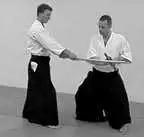 Harai, parry or warding off, sometimes spelled barai, is a term used not only in the sword art, but in some of the unarmed martial arts as well. It is neither a block nor only a parry, but a way of pushing uke's attack — either ahead in line with uke's aim, or to the side, downward or upward. By not only blocking uke's move but giving it an additional impulse, it will take longer for uke to counter. Also, by such a move the practical options for uke's next attack can be limited.
Harai, parry or warding off, sometimes spelled barai, is a term used not only in the sword art, but in some of the unarmed martial arts as well. It is neither a block nor only a parry, but a way of pushing uke's attack — either ahead in line with uke's aim, or to the side, downward or upward. By not only blocking uke's move but giving it an additional impulse, it will take longer for uke to counter. Also, by such a move the practical options for uke's next attack can be limited.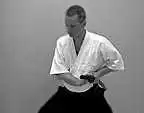 Tori needs to take care in doing the harai of movement four, since this is just about the only technique in the Aikibatto Shoden, where one might actually injure oneself, if doing wrong. The right hand cannot grip the hilt until after the warding off, or tori's fingers would smash uke's bokken, and the former are more likely to give than the latter. Instead, the right hand is kept open, and the palm presses on the hilt, on the side away from where it hits uke's bokken.
Tori needs to take care in doing the harai of movement four, since this is just about the only technique in the Aikibatto Shoden, where one might actually injure oneself, if doing wrong. The right hand cannot grip the hilt until after the warding off, or tori's fingers would smash uke's bokken, and the former are more likely to give than the latter. Instead, the right hand is kept open, and the palm presses on the hilt, on the side away from where it hits uke's bokken.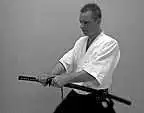 At tsuka ate, too, the sword is firmly held inside the scabbard. At that time, the right hand also has a firm grip, but on the hilt. A lot of the power in this strike comes from the body turn. In the harai move, tori has turned sideways, and tsuki is done when turning back to facing uke straight on.
At tsuka ate, too, the sword is firmly held inside the scabbard. At that time, the right hand also has a firm grip, but on the hilt. A lot of the power in this strike comes from the body turn. In the harai move, tori has turned sideways, and tsuki is done when turning back to facing uke straight on.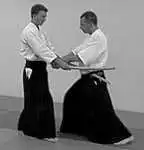 A good balance is also needed for pushing uke backward with an extension of the tsuki technique, in movement five. Normally, this extending of the tsuki would be done without a pause, but then the partner is sure to feel discomfort, to say the least. Therefore, the tsuki move is stopped, at a slight contact with uke's belly, and then continued in a push.
A good balance is also needed for pushing uke backward with an extension of the tsuki technique, in movement five. Normally, this extending of the tsuki would be done without a pause, but then the partner is sure to feel discomfort, to say the least. Therefore, the tsuki move is stopped, at a slight contact with uke's belly, and then continued in a push.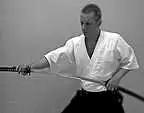 The draw of the sword is done by sliding back left hand and turning the body to the left — not by extending the sword additionally forward, where uke might be able to reach and block it. With a real sword, the left hand draws back the scabbard, while the right hand keeps the sword in place.
The draw of the sword is done by sliding back left hand and turning the body to the left — not by extending the sword additionally forward, where uke might be able to reach and block it. With a real sword, the left hand draws back the scabbard, while the right hand keeps the sword in place.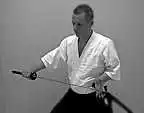 As soon as the sword point leaves the scabbard, left hand gets behind it, starting to press the palm of the hand on the back of the sword. This is for support in the short and quick do, side cut, done next, when uke steps forward again for a second attack.
As soon as the sword point leaves the scabbard, left hand gets behind it, starting to press the palm of the hand on the back of the sword. This is for support in the short and quick do, side cut, done next, when uke steps forward again for a second attack.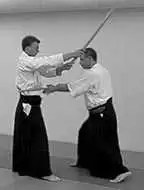 Uke's second attack is chudan giri, cut to middle level, but it might as well be men or gedan, making no difference to tori. If it is a chudan tsuki again, though, tori might find it difficult to sneak in with the sword under uke's guard, for the do cut. On the other hand, uke is not likely to choose the tsuki, since tori's sword is even more in the way, there at middle level. If uke were to try a jodan tsuki, thrust on high level, tori should not have too much trouble finding room for the do.
Uke's second attack is chudan giri, cut to middle level, but it might as well be men or gedan, making no difference to tori. If it is a chudan tsuki again, though, tori might find it difficult to sneak in with the sword under uke's guard, for the do cut. On the other hand, uke is not likely to choose the tsuki, since tori's sword is even more in the way, there at middle level. If uke were to try a jodan tsuki, thrust on high level, tori should not have too much trouble finding room for the do.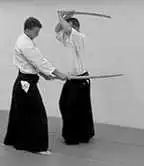 The do cut is quickly followed by a body turn on uke's left side, while simultaneously raising the sword to jodan kamae, and then a men, cut to the head. The raising of the sword to the high level guard, should be done to the position where tori will be at the end of the step in movement eight — this is much quicker than first raising the sword and then moving one's body.
The do cut is quickly followed by a body turn on uke's left side, while simultaneously raising the sword to jodan kamae, and then a men, cut to the head. The raising of the sword to the high level guard, should be done to the position where tori will be at the end of the step in movement eight — this is much quicker than first raising the sword and then moving one's body.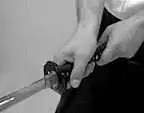 The chiburi I call kaiten, rotating, because it involves a 360° spin of the sword around its own axis, counterclockwise. This way of chiburi, shaking off the blood, is popular in many iaido schools, but it takes some time to learn — and in the meantime there is a great risk of dropping one's sword, which is as noisy as it is embarrassing. I recommend some practice at home.
The chiburi I call kaiten, rotating, because it involves a 360° spin of the sword around its own axis, counterclockwise. This way of chiburi, shaking off the blood, is popular in many iaido schools, but it takes some time to learn — and in the meantime there is a great risk of dropping one's sword, which is as noisy as it is embarrassing. I recommend some practice at home.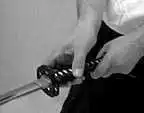
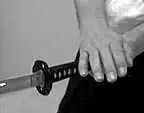
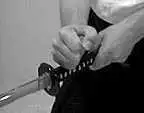 The left hand grip at the end of the hilt, is fixed in its position in front of tanden, the center, but opening a little, for the sword to spin around inside of it. As soon as the sword has spun around one full 360°, the left hand grips it firmly again. The right hand fist hits the hilt from above, as an additional chiburi move.
The left hand grip at the end of the hilt, is fixed in its position in front of tanden, the center, but opening a little, for the sword to spin around inside of it. As soon as the sword has spun around one full 360°, the left hand grips it firmly again. The right hand fist hits the hilt from above, as an additional chiburi move.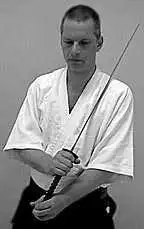 Also with the noto there are several ways of doing it. I prefer the way Nishio sensei teaches, which seems to me to be the safe and controlled way of handling the sword — a most important aspect, since the blade is placed on the shoulder, right by one's own neck.
Also with the noto there are several ways of doing it. I prefer the way Nishio sensei teaches, which seems to me to be the safe and controlled way of handling the sword — a most important aspect, since the blade is placed on the shoulder, right by one's own neck.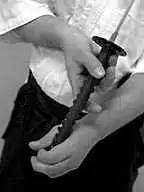 Start by tipping the sword up from the chudan kamae position, to one where the back of the blade rests on the left shoulder. This is done by keeping the left hand grip in a fixed position in front of tanden, the center, while the right hand drags the sword up. It is a good precaution to make the edge of the blade point slightly to the left, away from the neck.
Start by tipping the sword up from the chudan kamae position, to one where the back of the blade rests on the left shoulder. This is done by keeping the left hand grip in a fixed position in front of tanden, the center, while the right hand drags the sword up. It is a good precaution to make the edge of the blade point slightly to the left, away from the neck.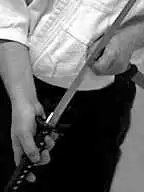 Next, release the right hand and grip the hilt anew, from below, with the thumb away from the tsuba, the sword guard. Then the left hand grabs the scabbard, around its opening, and lifts it a bit toward the blade, which can then slide on that grip until the sword point can enter the scabbard.
Next, release the right hand and grip the hilt anew, from below, with the thumb away from the tsuba, the sword guard. Then the left hand grabs the scabbard, around its opening, and lifts it a bit toward the blade, which can then slide on that grip until the sword point can enter the scabbard.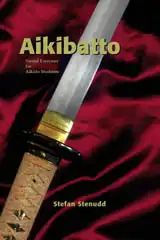 Aikibatto — Sword Exercises for Aikido Students
Aikibatto — Sword Exercises for Aikido Students